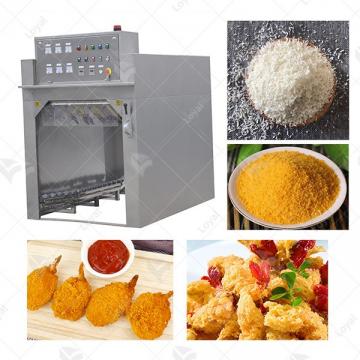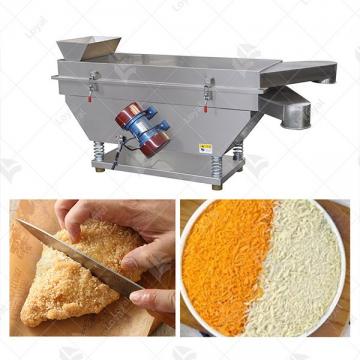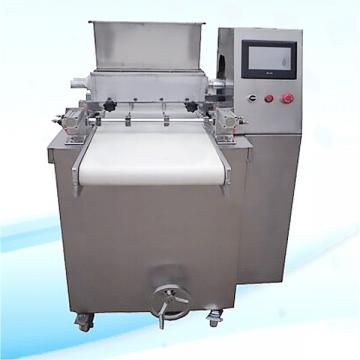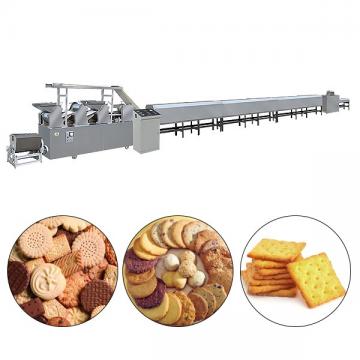
- Shandong Loyal Industrial Co.,Ltd.
- Macaroni Production Machine Instant Noodle Machine Biscuit Making Machine
Home> Processing> How To Choose The Best automatic biscuit production line: 2025 Buyer’s Guide

How To Choose The Best automatic biscuit production line: 2025 Buyer’s Guide
2025-05-17 15:13:50if you want to know more story about LOYAL brand, here can help you - https://www.facebook.com/Foodextruderfactory/
Imagine this scene: the lazy afternoon sunshine into the room, you tear open a bag of cookies, accompanied by “click” a crunch, the rich wheat flavor instantly filled with. You gently bite down on a mouthful, crunchy texture bloomed between the lips and teeth - at this moment, have you ever wondered what kind of journey this small piece of cookie has gone through to become a delicacy in your hands from the raw material?
Globally, more than 130 billion dollars cookies are produced every year, and the annual consumption of the Chinese market alone reaches 10 million dollars . Behind such a huge number is the efficient operation and precise control of modern cookie production lines. From the selection of flour to the baking temperature, from the precision of molding to the sealing of packaging, every link is condensed with the wisdom of the food industry.
So, how is a seemingly simple cookie “born” on a modern production line? The journey begins with high-quality ingredients meticulously measured and mixed in large industrial mixers, creating a dough that is both smooth and elastic. This dough is then fed through automated rollers that shape it into thin sheets, which are cut into precise shapes by rotating blades. What are the differences between traditional handmade and industrialized production? Traditional methods involve artisans carefully crafting each cookie by hand, ensuring unique textures and flavors, while industrialized production uses advanced machinery to ensure uniformity, efficiency, and scalability. And what technology ensures that each cookie maintains a consistent crispness and aroma? State-of-the-art ovens with precise temperature controls bake the cookies to perfection, while conveyor belts move them at optimal speeds to achieve the desired texture. After baking, they pass through cooling tunnels where air circulation systems maintain their crispness. Today, we will take you into the “industrial magic world” of cookie production and reveal the technology and craftsmanship behind it. From the initial mixing to the final packaging, every step is designed to deliver a delightful, consistently delicious treat.
This automatic biscuit production line, developed through the careful integration of advanced Japanese technology, features cutting-edge equipment design. It boasts a sleek, compact, and robust structure capable of withstanding rigorous daily operations while maintaining high automation. The line efficiently manages every step of the biscuit-making process, from evenly distributing dough during feed rolling to precisely shaping biscuits, followed by waste recycling, thorough drying, delicate coating, and final cooling, all in a seamless continuous operation. The feed rollers ensure the dough is uniformly spread, creating consistent thickness and texture. The shaping unit employs precision mechanisms to form intricate designs and patterns, enhancing the visual appeal of each biscuit. Waste recycling systems collect excess dough and re-integrate it into the production cycle, minimizing waste and maximizing efficiency. The drying phase utilizes gentle heat to achieve optimal moisture levels, ensuring crispness without compromising flavor. Delicate coating stations apply a variety of toppings, such as chocolate, sugar, or nuts, with pinpoint accuracy. The final cooling stage stabilizes the biscuits, preserving their shape and enhancing their shelf life. Users have access to hundreds of molds for various shapes and sizes, along with dozens of carefully crafted formulas, enabling versatile and customizable production. By simply changing the mold and adjusting the process recipe, manufacturers can easily produce a wide range of popular high-end cookies with unique textures, rich flavors, and appealing appearances, catering to diverse consumer preferences. Each cookie emerges from the line with a perfect balance of crunch and softness, inviting consumers to savor the delightful combination of taste and texture.

Biscuit Forming Process
DOUGH MIXING MACHINE →SOFT&HARD BISCUIT SHAPING MACHINE → TUNNEL BELT OVEN→ SPRAYING MACHINES →COOLER
Multifunctional biscuit make machine process is a precise manufacturing procedure that integrates food science with mechanical automation. The entire production line, from raw material mixing to finished product packaging, is meticulously designed to ensure the product achieves optimal taste and quality standards.
The production process begins with the flour mixing stage, which is carried out by professional mixers. The mixer combines high-quality wheat flour, fresh eggs, fine sugar, and various seasonings according to strict proportions. Through the rotational movement of dual stirring paddles, all ingredients are thoroughly blended. Modern mixing equipment typically includes temperature control systems that maintain the mixture's temperature within an ideal range, ensuring the dough has the perfect elasticity and consistency. After 10-15 minutes of thorough mixing, the uniform dough is automatically conveyed to the next stage.
The shaping process varies depending on the type of product. For hard biscuits, a roller cutting machine is used, where the dough is pressed through multiple rollers to form a uniformly thick sheet, which is then cut using specially designed molds. Soft biscuits, on the other hand, are made using a roller imprinting machine, where the dough is shaped on rollers with engraved patterns, creating beautiful three-dimensional designs on the surface of the biscuits. During the shaping process, an advanced visual inspection system continuously monitors the shape integrity of each biscuit, automatically removing any substandard semi-finished products.
Baking is the critical step that determines the final quality of the biscuits. Tunnel ovens are designed with multiple temperature zones, and the biscuits are conveyed through preheating, baking, and coloring sections. The preheating zone maintains temperatures between 120-150°C to initially set the internal structure of the biscuits; the baking zone raises the temperature to 180-220°C to promote the Maillard reaction, producing unique aromas and colors; finally, the coloring zone precisely controls the surface color. Modern ovens are equipped with hot air circulation systems to ensure uniform temperature distribution within the oven, with a temperature difference not exceeding ±3°C.
After baking, the cookies undergo an oil spraying process that imparts a unique flavor and sheen. The automatic oil spraying system uses high-pressure atomization technology to evenly spray edible oil on the cookie surface, with the amount of oil controlled by a precise metering pump to be between 0.5 and 1.grams per cookie. Some premium products also add flavored oils or nutritional enhancers at this stage to increase their added value.
The cooling process is equally crucial, as freshly baked cookies need to pass through a cooling conveyor belt that is 15 to 20 meters long. This specially designed conveyor system is equipped with temperature and humidity control devices, using a combination of natural convection and forced ventilation to gradually reduce the cookie temperature from around 80°C to room temperature. During this process, moisture inside the cookies continues to distribute evenly, ultimately achieving the ideal crispy texture. At the end of the conveyor belt, a metal detector performs the final quality check.

The Different Of Hard Biscuit And Soft Biscuit
1. Dough Characteristics
●Hard Biscuits
The dough has high elasticity and stretchiness, similar to bread dough.
Contains more gluten development, giving it a chewy, layered texture when baked.
Requires careful gluten formation during mixing to achieve proper structure.
Often uses less fat and sugar compared to soft biscuits, focusing more on flour strength.
●Soft Biscuits (Shortbread/Cookies)
The dough is crumbly, tender, and fragile with minimal gluten development.
Contains higher fat (butter/shortening) and sugar content, which inhibits gluten formation.
Has a short, melt-in-the-mouth texture due to the high fat ratio.
More delicate to handle, as overmixing can make it tough rather than flaky.
2. Dough Processing Methods
●Hard Biscuits
Requires multi-stage rolling and resting to relax gluten between passes.
Typically sheeted multiple times (3-5 passes) with resting periods in between.
The dough is elastic and shrinkable, so gradual rolling prevents deformation.
Often laminated (folded) to create flaky layers (e.g., crackers, puff biscuits).
●Soft Biscuits
Mixed just until combined—overmixing makes them tough.
Usually sheet-rolled once (no lamination needed) and cut directly.
The dough is non-elastic, so it holds its shape well after cutting.
Some recipes may require chilling before forming to prevent sticking.
3. Baking Process Differences
●Hard Biscuits
Baked at higher temperatures (180–250°C) to create a crisp texture.
Often drier and harder, requiring precise moisture control.
May undergo multi-zone baking to ensure even crispness without burning.
●Soft Biscuits
Baked at lower temperatures (160–190°C) to retain moisture and softness.
Shorter baking time to prevent over-drying.
Some varieties (like chewy cookies) remain slightly underbaked in the center for softness.
4. Final Product Texture & Applications
●Hard Biscuits
Crispy, crunchy, or layered (e.g., soda crackers, digestive biscuits).
Often used for dunking in tea/coffee due to sturdy structure.
Longer shelf life due to low moisture content.
●Soft Biscuits
Tender, crumbly, or chewy (e.g., shortbread, butter cookies, chocolate chip cookies).
Best enjoyed fresh; may soften over time due to higher fat content.
Popular as snack biscuits or dessert items.

What are the advantages of this line?
1.A complete soft and hard biscuit production line , which can make all kinds of biscuits of various shapes, just change the mold.
●Soft & Hard Biscuits: Adjust dough consistency, baking time, and temperature to produce chewy, crispy, or layered biscuits.
●Multiple Shapes & Designs: Simply change the mold to switch between round, square, animal-shaped, or custom-designed biscuits.
●Wide Recipe Compatibility: Works with various dough types, including sugar-based, savory, gluten-free, and high-fiber recipes.
2.The biscuit production line can be customized according to the customer's workshop or biscuit making technical requirement
●Adaptable Layout: The machine can be adjusted in size, conveyor length, and configuration to fit small, medium, or large workshops.
●Tailored Technical Specifications: Customize baking time, temperature zones, and cooling speed based on your biscuit type.
●Optional Add-ons: Additional modules like chocolate coating, cream filling, or double-layer baking can be integrated.
3.Have different heating sources for your operation (Electric, gas, Diesel oil)
●Electric Heating: Best for stable temperature control, suitable for indoor factories with electricity supply.
●Gas Heating: Cost-effective for large-scale production with consistent heat distribution.
●Diesel Oil Heating: Ideal for areas with limited gas or electricity access, providing high thermal efficiency.
4.It is full automatic, advanced technology, easy to operation, high quality,save energy & labor, reasonable price to win customer reply and reputation.
●PLC Touch Screen Control: Easy-to-use interface for adjusting speed, temperature, and baking time.
●Energy-Saving Design: Optimized heat circulation and insulation reduce power consumption.
●Minimal Labor Requirement: Automated feeding, forming, baking, and packaging reduce manual work.
●Smooth & Stable Performance: Precision-engineered components ensure low maintenance and long service life
●In today's increasingly competitive biscuit industry, (company name) focuses on real challenges in production and helps customers :
Reduce energy costs
Improve yield
Gain small-lot flexible production capacity
The automatic biscuit production line is composed of cookie forming machine, electric baking oven, oil spraying machine, turning machine, cooling line, cookie finishing machine, packing table and so on. The whole line is controlled by CPU module, back hung motor drive, compact structure and high degree of automation. The machine can also produce various flavors of high quality cookies, such as cream, jam, etc.
Biscuit Maker (Cookie Pastry Machine, is a forming machine that can produce a variety of unique fancy snacks and cookie blanks by extrusion of dough.The machine has a variety of molds and can produce dozens of fancy cookies, and users can adjust and choose according to their needs. Formed fancy Desserts and cookies have unique shapes, clear patterns and beautiful shapes. The shaped cookies by this machine can be baked in a hot air rotary furnace and a tunnel furnace.
The automatic biscuit production line adopts advanced technology at home and abroad, uses the best quality food-grade materials, and is equipped with many different models, allowing manufacturers to produce various types of chocolate sandwich cookies, hard cookies, and soda cookies according to market demand. The equipment has very mature technology, the critical components of the control and operation more accurate and safe, while the manufacturer can provide perfect after-sales service. This machine is the major manufacturers are competing to buy the equipment.

Reference
The following are five authoritative foreign literature websites in the field of Industrial food machinery:
1. Food Engineering Magazine
Website: https://www.foodengineeringmag.com/
2.Food Processing Magazine
Website: https://www.foodprocessing.com/
3.Journal of Food Engineering
Website:https://www.journals.elsevier.com/journal-of-food-engineering
4. Food Manufacturing Magazine
Website:https://www.foodmanufacturing.com/
5. International Journal of Food Science & Technology
Website:https://onlinelibrary.wiley.com/
 Commercial Japanese Panko Bread Crumb Grinder Machine
Commercial Japanese Panko Bread Crumb Grinder Machine Japanese Bread Crumbs Processing Line
Japanese Bread Crumbs Processing Line Automatic Cookies Making Machines
Automatic Cookies Making Machines Fully Automatic Biscuit Making Machines
Fully Automatic Biscuit Making Machines